Management Accounting: Systems, Reporting, Budgeting and Control
VerifiedAdded on 2023/01/13
|15
|3062
|57
Report
AI Summary
This report provides a detailed analysis of management accounting systems, reporting methods, and budgetary control techniques. It begins by defining management accounting and its functions, comparing it with financial accounting and cost accounting systems. Various reporting methods, including trading and profit & loss accounts, income statements, balance sheets, and cash flow statements, are discussed. The report explores cost calculation techniques, such as marginal costing and absorption costing, and their application in preparing income statements. Different planning tools used for budgetary control, including sales budgets, production budgets, cash budgets, and flexible budgets, are evaluated. Furthermore, the report compares adaptation methods like benchmarks, key performance indicators, balanced scorecards, and budgetary targets, adopted by organizations in response to financial systems. It concludes by highlighting the importance of financial governance for sustainable success, emphasizing compliance and disclosure norms. Desklib provides access to this and many other solved assignments to help students excel.
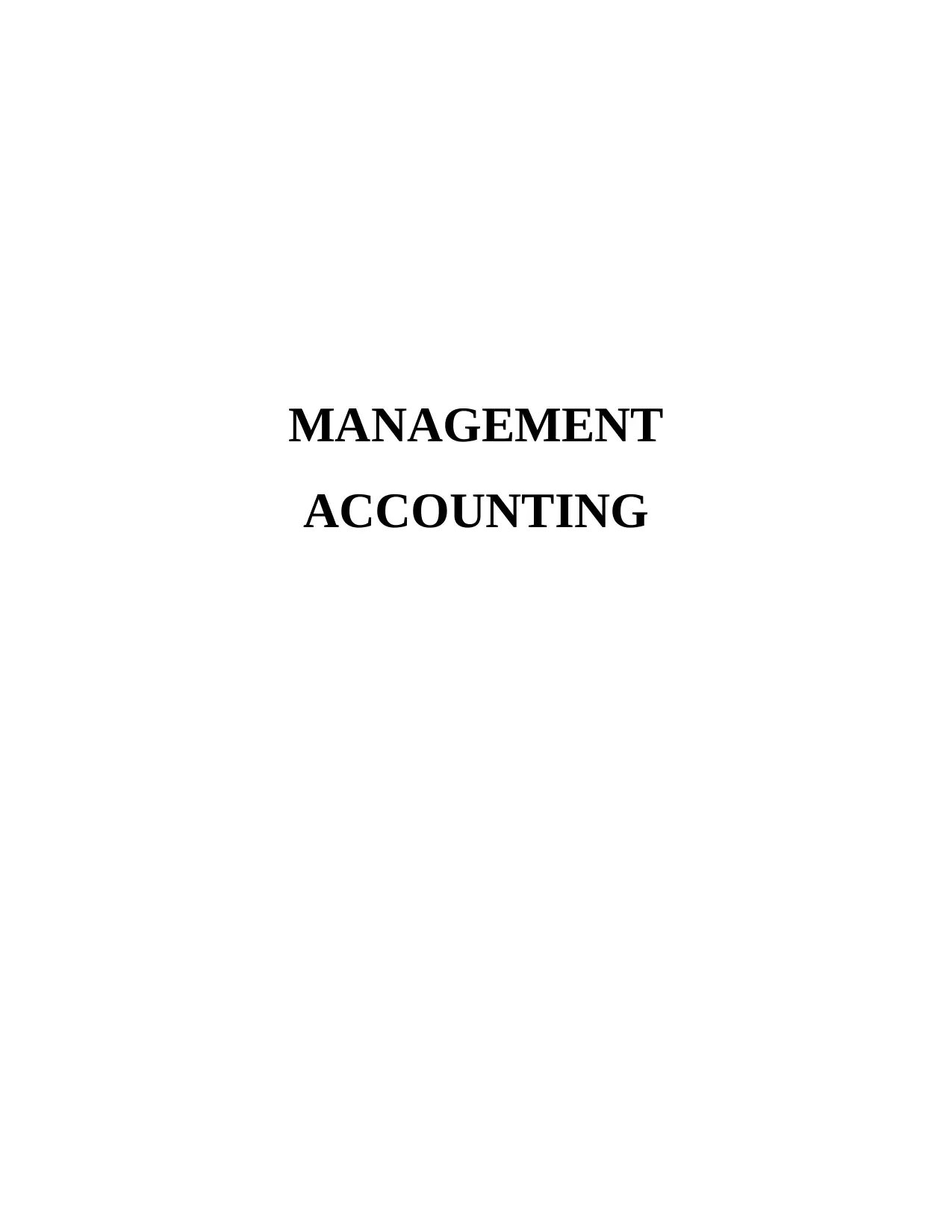
MANAGEMENT
ACCOUNTING
ACCOUNTING
Paraphrase This Document
Need a fresh take? Get an instant paraphrase of this document with our AI Paraphraser
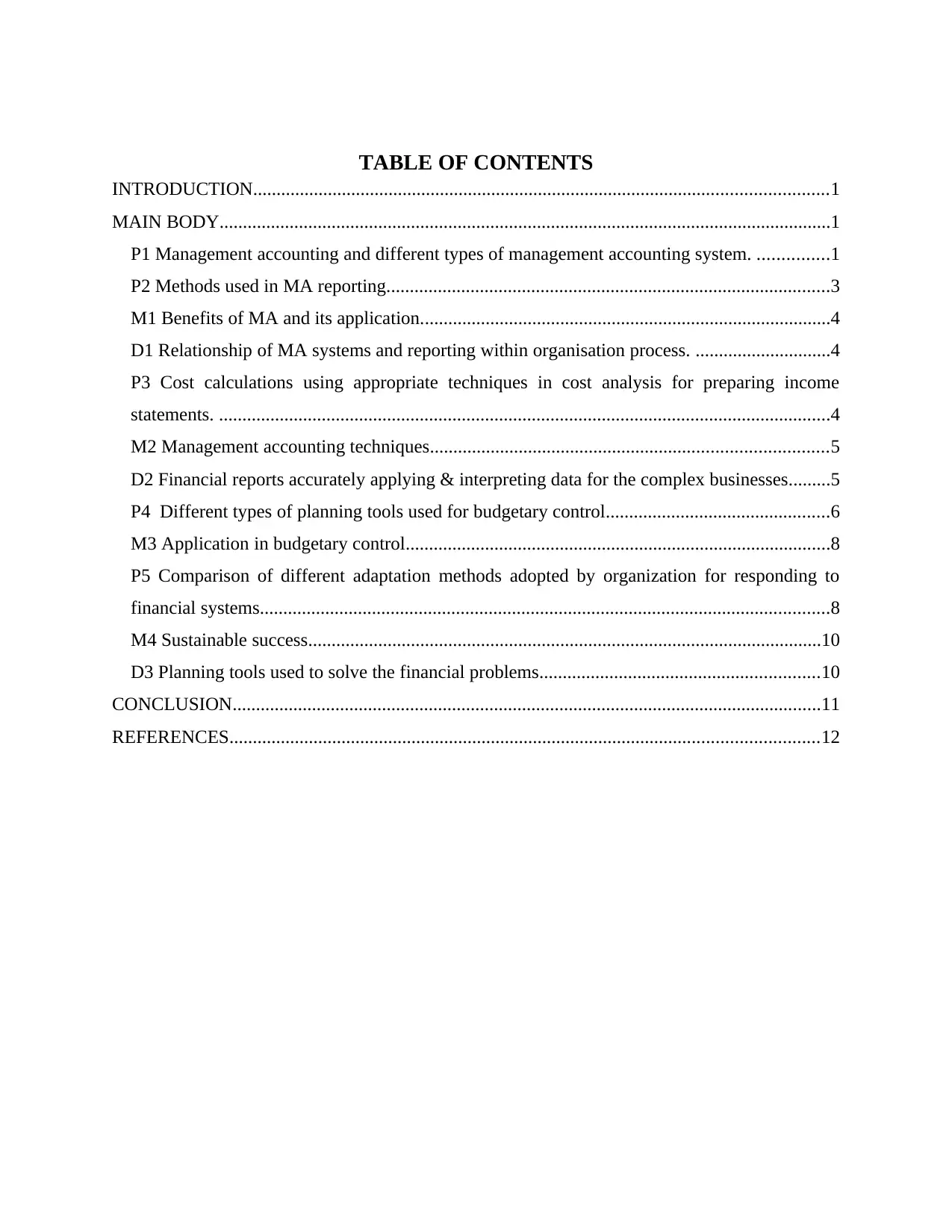
TABLE OF CONTENTS
INTRODUCTION...........................................................................................................................1
MAIN BODY...................................................................................................................................1
P1 Management accounting and different types of management accounting system. ...............1
P2 Methods used in MA reporting...............................................................................................3
M1 Benefits of MA and its application........................................................................................4
D1 Relationship of MA systems and reporting within organisation process. .............................4
P3 Cost calculations using appropriate techniques in cost analysis for preparing income
statements. ...................................................................................................................................4
M2 Management accounting techniques.....................................................................................5
D2 Financial reports accurately applying & interpreting data for the complex businesses.........5
P4 Different types of planning tools used for budgetary control................................................6
M3 Application in budgetary control...........................................................................................8
P5 Comparison of different adaptation methods adopted by organization for responding to
financial systems..........................................................................................................................8
M4 Sustainable success..............................................................................................................10
D3 Planning tools used to solve the financial problems............................................................10
CONCLUSION..............................................................................................................................11
REFERENCES..............................................................................................................................12
INTRODUCTION...........................................................................................................................1
MAIN BODY...................................................................................................................................1
P1 Management accounting and different types of management accounting system. ...............1
P2 Methods used in MA reporting...............................................................................................3
M1 Benefits of MA and its application........................................................................................4
D1 Relationship of MA systems and reporting within organisation process. .............................4
P3 Cost calculations using appropriate techniques in cost analysis for preparing income
statements. ...................................................................................................................................4
M2 Management accounting techniques.....................................................................................5
D2 Financial reports accurately applying & interpreting data for the complex businesses.........5
P4 Different types of planning tools used for budgetary control................................................6
M3 Application in budgetary control...........................................................................................8
P5 Comparison of different adaptation methods adopted by organization for responding to
financial systems..........................................................................................................................8
M4 Sustainable success..............................................................................................................10
D3 Planning tools used to solve the financial problems............................................................10
CONCLUSION..............................................................................................................................11
REFERENCES..............................................................................................................................12
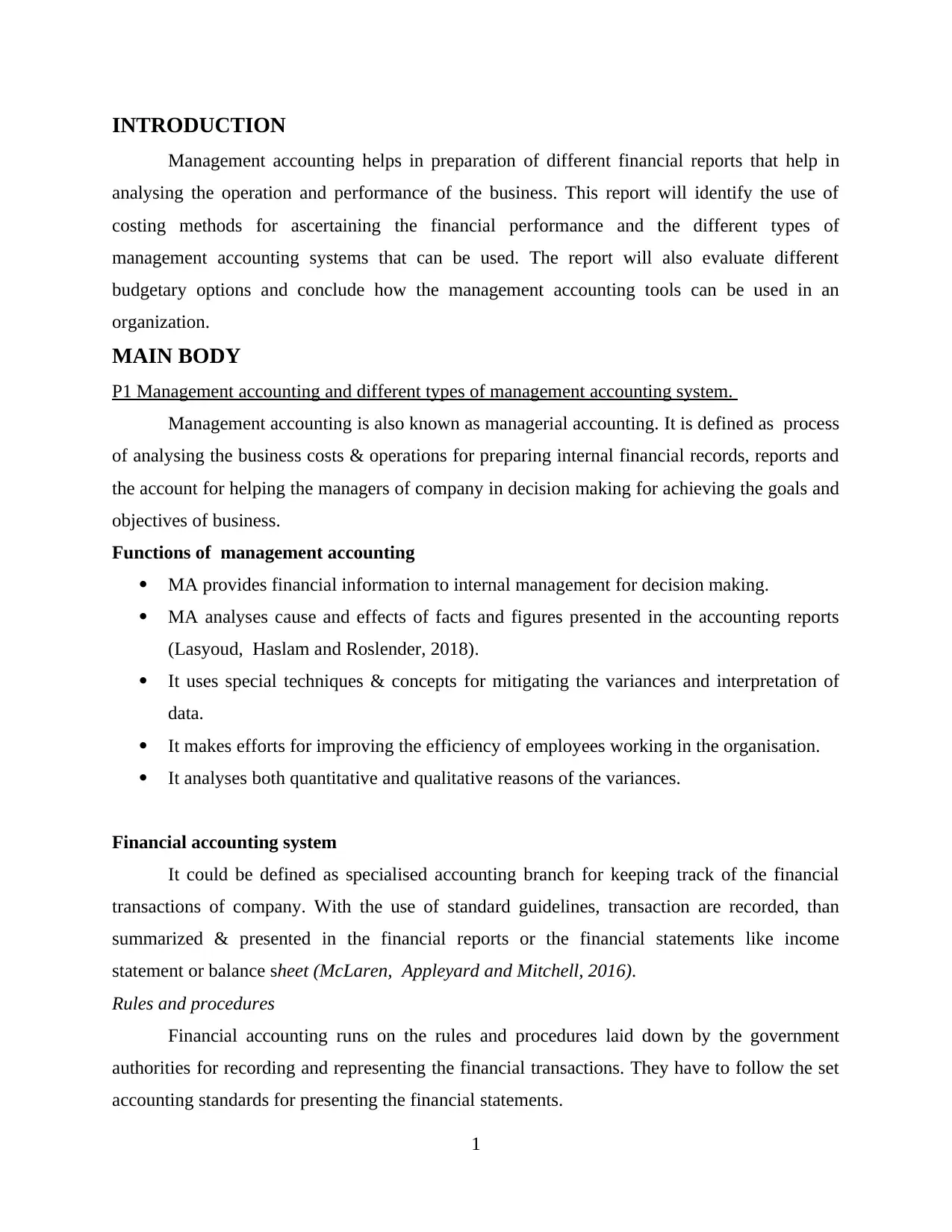
INTRODUCTION
Management accounting helps in preparation of different financial reports that help in
analysing the operation and performance of the business. This report will identify the use of
costing methods for ascertaining the financial performance and the different types of
management accounting systems that can be used. The report will also evaluate different
budgetary options and conclude how the management accounting tools can be used in an
organization.
MAIN BODY
P1 Management accounting and different types of management accounting system.
Management accounting is also known as managerial accounting. It is defined as process
of analysing the business costs & operations for preparing internal financial records, reports and
the account for helping the managers of company in decision making for achieving the goals and
objectives of business.
Functions of management accounting
MA provides financial information to internal management for decision making.
MA analyses cause and effects of facts and figures presented in the accounting reports
(Lasyoud, Haslam and Roslender, 2018).
It uses special techniques & concepts for mitigating the variances and interpretation of
data.
It makes efforts for improving the efficiency of employees working in the organisation.
It analyses both quantitative and qualitative reasons of the variances.
Financial accounting system
It could be defined as specialised accounting branch for keeping track of the financial
transactions of company. With the use of standard guidelines, transaction are recorded, than
summarized & presented in the financial reports or the financial statements like income
statement or balance sheet (McLaren, Appleyard and Mitchell, 2016).
Rules and procedures
Financial accounting runs on the rules and procedures laid down by the government
authorities for recording and representing the financial transactions. They have to follow the set
accounting standards for presenting the financial statements.
1
Management accounting helps in preparation of different financial reports that help in
analysing the operation and performance of the business. This report will identify the use of
costing methods for ascertaining the financial performance and the different types of
management accounting systems that can be used. The report will also evaluate different
budgetary options and conclude how the management accounting tools can be used in an
organization.
MAIN BODY
P1 Management accounting and different types of management accounting system.
Management accounting is also known as managerial accounting. It is defined as process
of analysing the business costs & operations for preparing internal financial records, reports and
the account for helping the managers of company in decision making for achieving the goals and
objectives of business.
Functions of management accounting
MA provides financial information to internal management for decision making.
MA analyses cause and effects of facts and figures presented in the accounting reports
(Lasyoud, Haslam and Roslender, 2018).
It uses special techniques & concepts for mitigating the variances and interpretation of
data.
It makes efforts for improving the efficiency of employees working in the organisation.
It analyses both quantitative and qualitative reasons of the variances.
Financial accounting system
It could be defined as specialised accounting branch for keeping track of the financial
transactions of company. With the use of standard guidelines, transaction are recorded, than
summarized & presented in the financial reports or the financial statements like income
statement or balance sheet (McLaren, Appleyard and Mitchell, 2016).
Rules and procedures
Financial accounting runs on the rules and procedures laid down by the government
authorities for recording and representing the financial transactions. They have to follow the set
accounting standards for presenting the financial statements.
1
⊘ This is a preview!⊘
Do you want full access?
Subscribe today to unlock all pages.

Trusted by 1+ million students worldwide
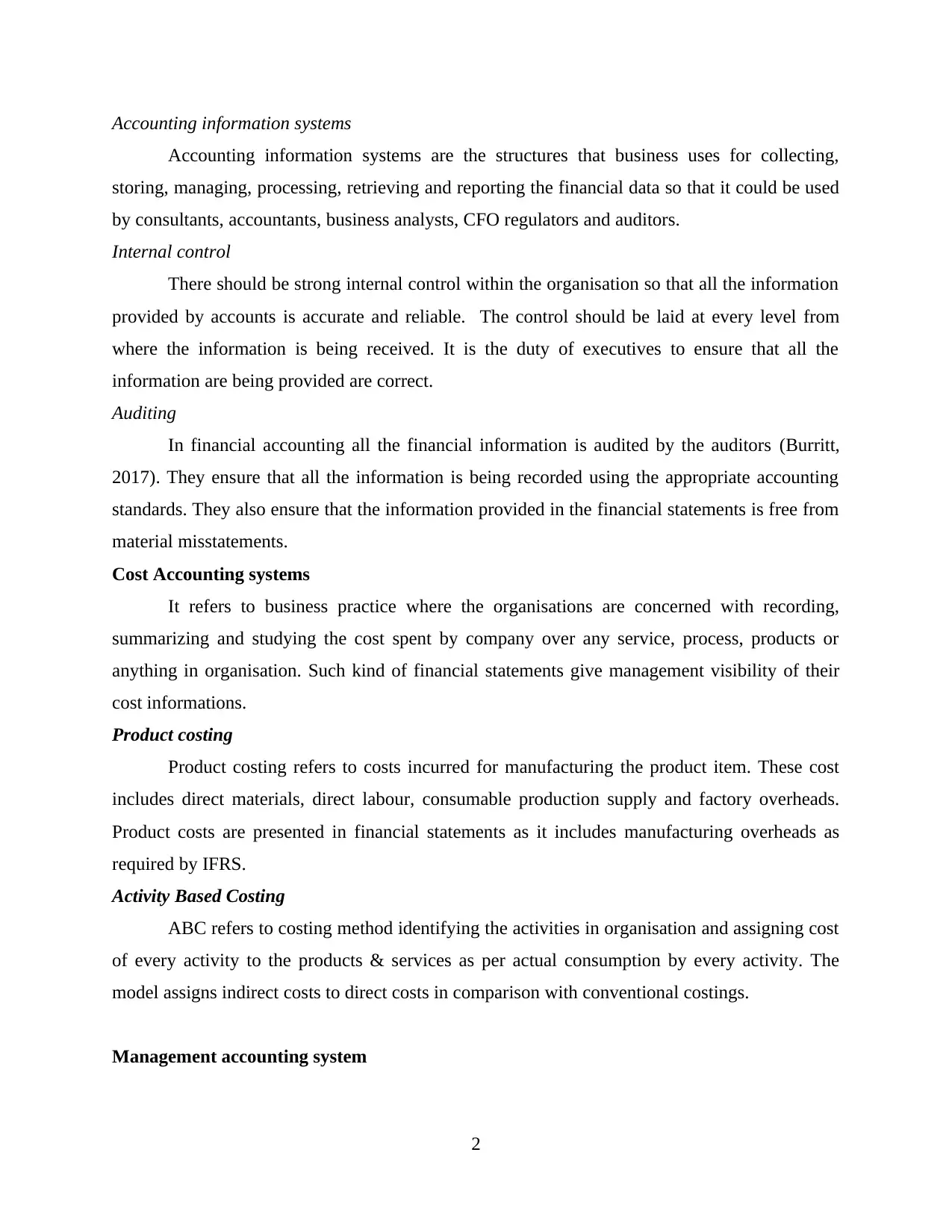
Accounting information systems
Accounting information systems are the structures that business uses for collecting,
storing, managing, processing, retrieving and reporting the financial data so that it could be used
by consultants, accountants, business analysts, CFO regulators and auditors.
Internal control
There should be strong internal control within the organisation so that all the information
provided by accounts is accurate and reliable. The control should be laid at every level from
where the information is being received. It is the duty of executives to ensure that all the
information are being provided are correct.
Auditing
In financial accounting all the financial information is audited by the auditors (Burritt,
2017). They ensure that all the information is being recorded using the appropriate accounting
standards. They also ensure that the information provided in the financial statements is free from
material misstatements.
Cost Accounting systems
It refers to business practice where the organisations are concerned with recording,
summarizing and studying the cost spent by company over any service, process, products or
anything in organisation. Such kind of financial statements give management visibility of their
cost informations.
Product costing
Product costing refers to costs incurred for manufacturing the product item. These cost
includes direct materials, direct labour, consumable production supply and factory overheads.
Product costs are presented in financial statements as it includes manufacturing overheads as
required by IFRS.
Activity Based Costing
ABC refers to costing method identifying the activities in organisation and assigning cost
of every activity to the products & services as per actual consumption by every activity. The
model assigns indirect costs to direct costs in comparison with conventional costings.
Management accounting system
2
Accounting information systems are the structures that business uses for collecting,
storing, managing, processing, retrieving and reporting the financial data so that it could be used
by consultants, accountants, business analysts, CFO regulators and auditors.
Internal control
There should be strong internal control within the organisation so that all the information
provided by accounts is accurate and reliable. The control should be laid at every level from
where the information is being received. It is the duty of executives to ensure that all the
information are being provided are correct.
Auditing
In financial accounting all the financial information is audited by the auditors (Burritt,
2017). They ensure that all the information is being recorded using the appropriate accounting
standards. They also ensure that the information provided in the financial statements is free from
material misstatements.
Cost Accounting systems
It refers to business practice where the organisations are concerned with recording,
summarizing and studying the cost spent by company over any service, process, products or
anything in organisation. Such kind of financial statements give management visibility of their
cost informations.
Product costing
Product costing refers to costs incurred for manufacturing the product item. These cost
includes direct materials, direct labour, consumable production supply and factory overheads.
Product costs are presented in financial statements as it includes manufacturing overheads as
required by IFRS.
Activity Based Costing
ABC refers to costing method identifying the activities in organisation and assigning cost
of every activity to the products & services as per actual consumption by every activity. The
model assigns indirect costs to direct costs in comparison with conventional costings.
Management accounting system
2
Paraphrase This Document
Need a fresh take? Get an instant paraphrase of this document with our AI Paraphraser
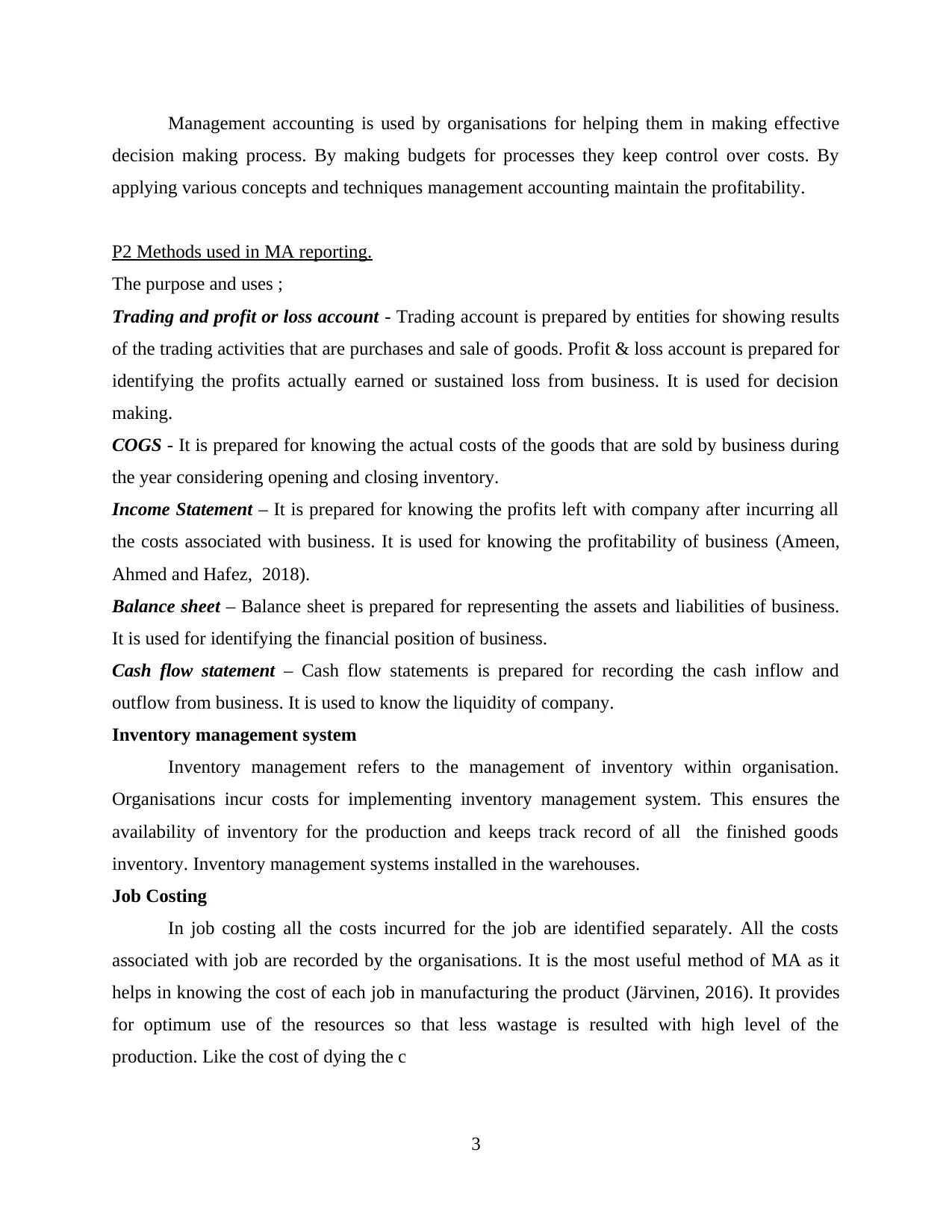
Management accounting is used by organisations for helping them in making effective
decision making process. By making budgets for processes they keep control over costs. By
applying various concepts and techniques management accounting maintain the profitability.
P2 Methods used in MA reporting.
The purpose and uses ;
Trading and profit or loss account - Trading account is prepared by entities for showing results
of the trading activities that are purchases and sale of goods. Profit & loss account is prepared for
identifying the profits actually earned or sustained loss from business. It is used for decision
making.
COGS - It is prepared for knowing the actual costs of the goods that are sold by business during
the year considering opening and closing inventory.
Income Statement – It is prepared for knowing the profits left with company after incurring all
the costs associated with business. It is used for knowing the profitability of business (Ameen,
Ahmed and Hafez, 2018).
Balance sheet – Balance sheet is prepared for representing the assets and liabilities of business.
It is used for identifying the financial position of business.
Cash flow statement – Cash flow statements is prepared for recording the cash inflow and
outflow from business. It is used to know the liquidity of company.
Inventory management system
Inventory management refers to the management of inventory within organisation.
Organisations incur costs for implementing inventory management system. This ensures the
availability of inventory for the production and keeps track record of all the finished goods
inventory. Inventory management systems installed in the warehouses.
Job Costing
In job costing all the costs incurred for the job are identified separately. All the costs
associated with job are recorded by the organisations. It is the most useful method of MA as it
helps in knowing the cost of each job in manufacturing the product (Järvinen, 2016). It provides
for optimum use of the resources so that less wastage is resulted with high level of the
production. Like the cost of dying the c
3
decision making process. By making budgets for processes they keep control over costs. By
applying various concepts and techniques management accounting maintain the profitability.
P2 Methods used in MA reporting.
The purpose and uses ;
Trading and profit or loss account - Trading account is prepared by entities for showing results
of the trading activities that are purchases and sale of goods. Profit & loss account is prepared for
identifying the profits actually earned or sustained loss from business. It is used for decision
making.
COGS - It is prepared for knowing the actual costs of the goods that are sold by business during
the year considering opening and closing inventory.
Income Statement – It is prepared for knowing the profits left with company after incurring all
the costs associated with business. It is used for knowing the profitability of business (Ameen,
Ahmed and Hafez, 2018).
Balance sheet – Balance sheet is prepared for representing the assets and liabilities of business.
It is used for identifying the financial position of business.
Cash flow statement – Cash flow statements is prepared for recording the cash inflow and
outflow from business. It is used to know the liquidity of company.
Inventory management system
Inventory management refers to the management of inventory within organisation.
Organisations incur costs for implementing inventory management system. This ensures the
availability of inventory for the production and keeps track record of all the finished goods
inventory. Inventory management systems installed in the warehouses.
Job Costing
In job costing all the costs incurred for the job are identified separately. All the costs
associated with job are recorded by the organisations. It is the most useful method of MA as it
helps in knowing the cost of each job in manufacturing the product (Järvinen, 2016). It provides
for optimum use of the resources so that less wastage is resulted with high level of the
production. Like the cost of dying the c
3
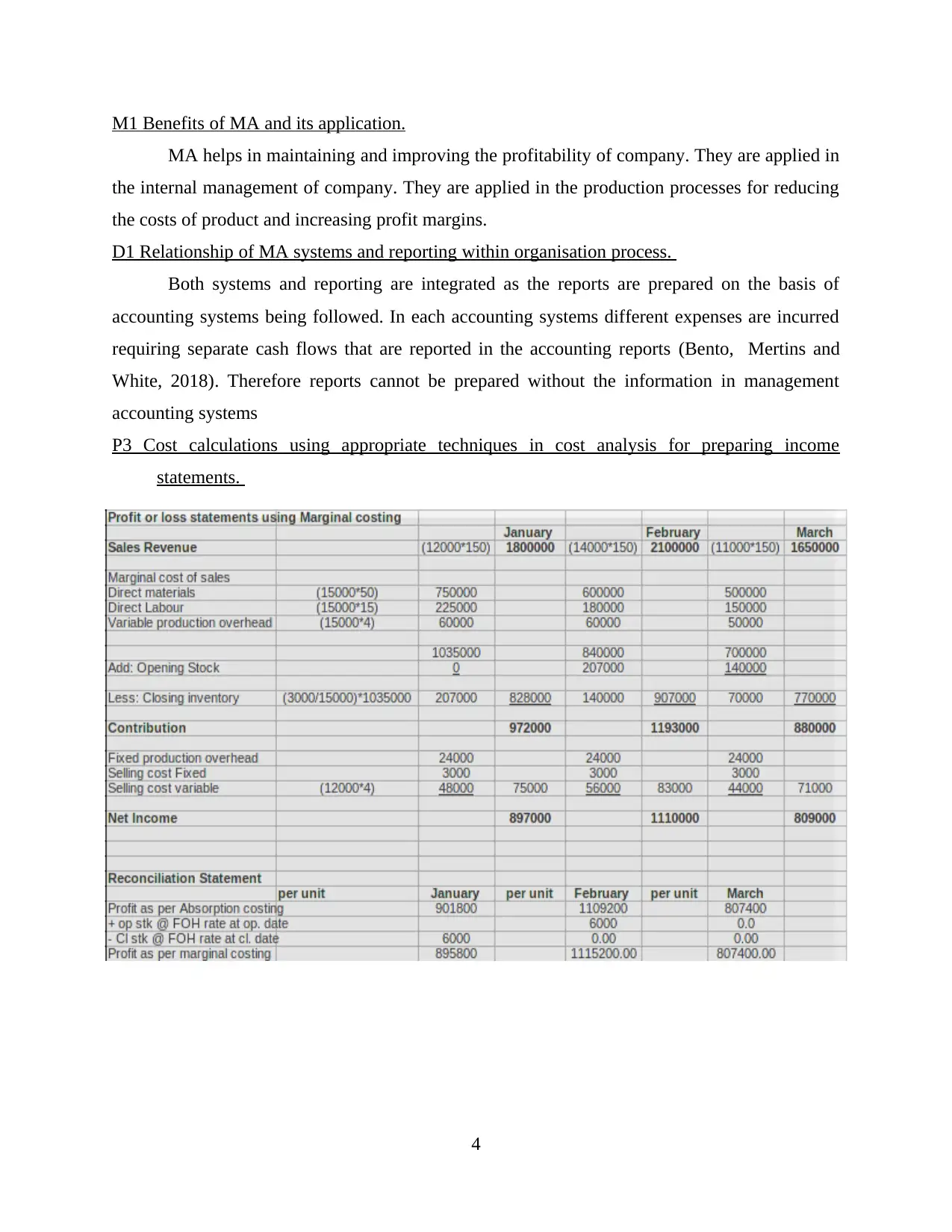
M1 Benefits of MA and its application.
MA helps in maintaining and improving the profitability of company. They are applied in
the internal management of company. They are applied in the production processes for reducing
the costs of product and increasing profit margins.
D1 Relationship of MA systems and reporting within organisation process.
Both systems and reporting are integrated as the reports are prepared on the basis of
accounting systems being followed. In each accounting systems different expenses are incurred
requiring separate cash flows that are reported in the accounting reports (Bento, Mertins and
White, 2018). Therefore reports cannot be prepared without the information in management
accounting systems
P3 Cost calculations using appropriate techniques in cost analysis for preparing income
statements.
4
MA helps in maintaining and improving the profitability of company. They are applied in
the internal management of company. They are applied in the production processes for reducing
the costs of product and increasing profit margins.
D1 Relationship of MA systems and reporting within organisation process.
Both systems and reporting are integrated as the reports are prepared on the basis of
accounting systems being followed. In each accounting systems different expenses are incurred
requiring separate cash flows that are reported in the accounting reports (Bento, Mertins and
White, 2018). Therefore reports cannot be prepared without the information in management
accounting systems
P3 Cost calculations using appropriate techniques in cost analysis for preparing income
statements.
4
⊘ This is a preview!⊘
Do you want full access?
Subscribe today to unlock all pages.

Trusted by 1+ million students worldwide
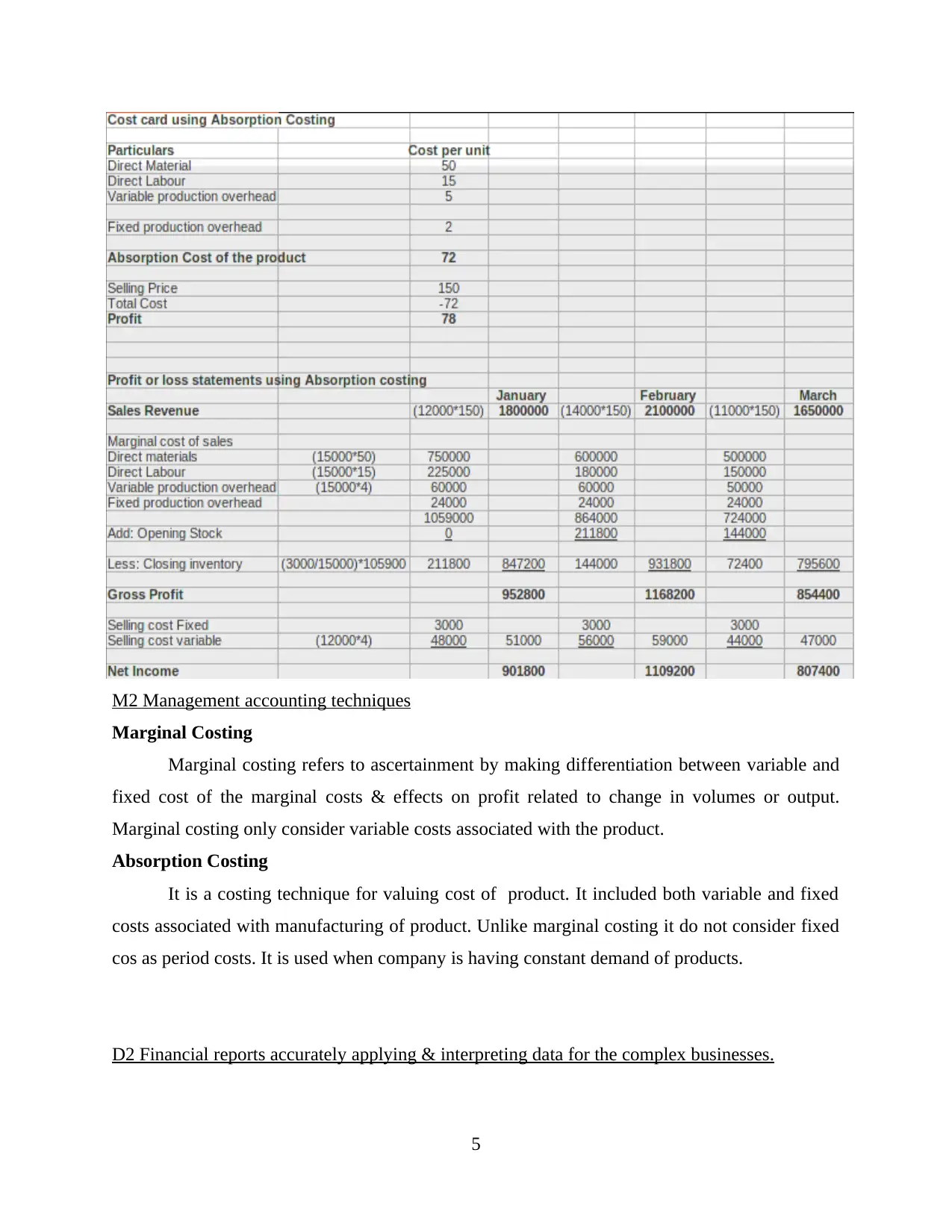
M2 Management accounting techniques
Marginal Costing
Marginal costing refers to ascertainment by making differentiation between variable and
fixed cost of the marginal costs & effects on profit related to change in volumes or output.
Marginal costing only consider variable costs associated with the product.
Absorption Costing
It is a costing technique for valuing cost of product. It included both variable and fixed
costs associated with manufacturing of product. Unlike marginal costing it do not consider fixed
cos as period costs. It is used when company is having constant demand of products.
D2 Financial reports accurately applying & interpreting data for the complex businesses.
5
Marginal Costing
Marginal costing refers to ascertainment by making differentiation between variable and
fixed cost of the marginal costs & effects on profit related to change in volumes or output.
Marginal costing only consider variable costs associated with the product.
Absorption Costing
It is a costing technique for valuing cost of product. It included both variable and fixed
costs associated with manufacturing of product. Unlike marginal costing it do not consider fixed
cos as period costs. It is used when company is having constant demand of products.
D2 Financial reports accurately applying & interpreting data for the complex businesses.
5
Paraphrase This Document
Need a fresh take? Get an instant paraphrase of this document with our AI Paraphraser
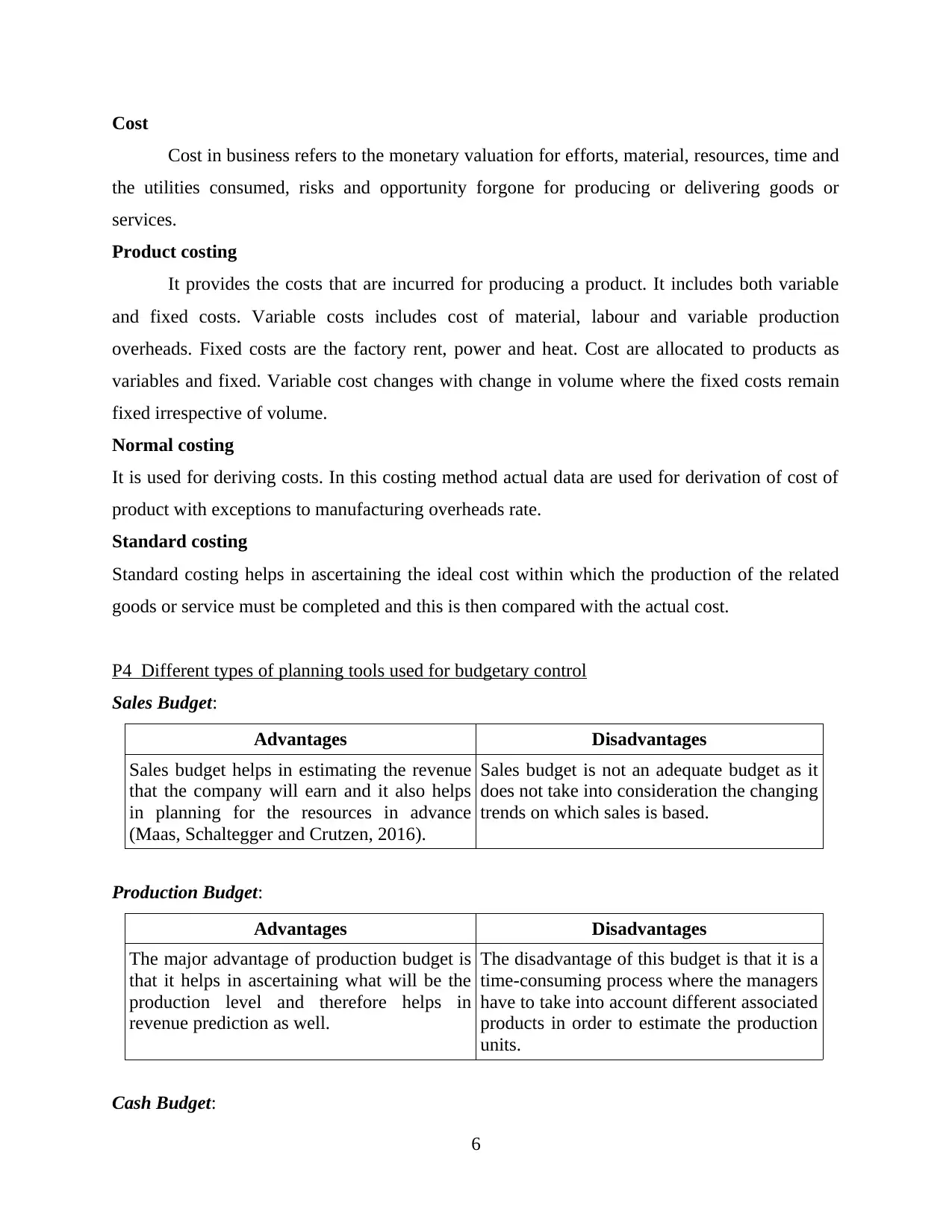
Cost
Cost in business refers to the monetary valuation for efforts, material, resources, time and
the utilities consumed, risks and opportunity forgone for producing or delivering goods or
services.
Product costing
It provides the costs that are incurred for producing a product. It includes both variable
and fixed costs. Variable costs includes cost of material, labour and variable production
overheads. Fixed costs are the factory rent, power and heat. Cost are allocated to products as
variables and fixed. Variable cost changes with change in volume where the fixed costs remain
fixed irrespective of volume.
Normal costing
It is used for deriving costs. In this costing method actual data are used for derivation of cost of
product with exceptions to manufacturing overheads rate.
Standard costing
Standard costing helps in ascertaining the ideal cost within which the production of the related
goods or service must be completed and this is then compared with the actual cost.
P4 Different types of planning tools used for budgetary control
Sales Budget:
Advantages Disadvantages
Sales budget helps in estimating the revenue
that the company will earn and it also helps
in planning for the resources in advance
(Maas, Schaltegger and Crutzen, 2016).
Sales budget is not an adequate budget as it
does not take into consideration the changing
trends on which sales is based.
Production Budget:
Advantages Disadvantages
The major advantage of production budget is
that it helps in ascertaining what will be the
production level and therefore helps in
revenue prediction as well.
The disadvantage of this budget is that it is a
time-consuming process where the managers
have to take into account different associated
products in order to estimate the production
units.
Cash Budget:
6
Cost in business refers to the monetary valuation for efforts, material, resources, time and
the utilities consumed, risks and opportunity forgone for producing or delivering goods or
services.
Product costing
It provides the costs that are incurred for producing a product. It includes both variable
and fixed costs. Variable costs includes cost of material, labour and variable production
overheads. Fixed costs are the factory rent, power and heat. Cost are allocated to products as
variables and fixed. Variable cost changes with change in volume where the fixed costs remain
fixed irrespective of volume.
Normal costing
It is used for deriving costs. In this costing method actual data are used for derivation of cost of
product with exceptions to manufacturing overheads rate.
Standard costing
Standard costing helps in ascertaining the ideal cost within which the production of the related
goods or service must be completed and this is then compared with the actual cost.
P4 Different types of planning tools used for budgetary control
Sales Budget:
Advantages Disadvantages
Sales budget helps in estimating the revenue
that the company will earn and it also helps
in planning for the resources in advance
(Maas, Schaltegger and Crutzen, 2016).
Sales budget is not an adequate budget as it
does not take into consideration the changing
trends on which sales is based.
Production Budget:
Advantages Disadvantages
The major advantage of production budget is
that it helps in ascertaining what will be the
production level and therefore helps in
revenue prediction as well.
The disadvantage of this budget is that it is a
time-consuming process where the managers
have to take into account different associated
products in order to estimate the production
units.
Cash Budget:
6
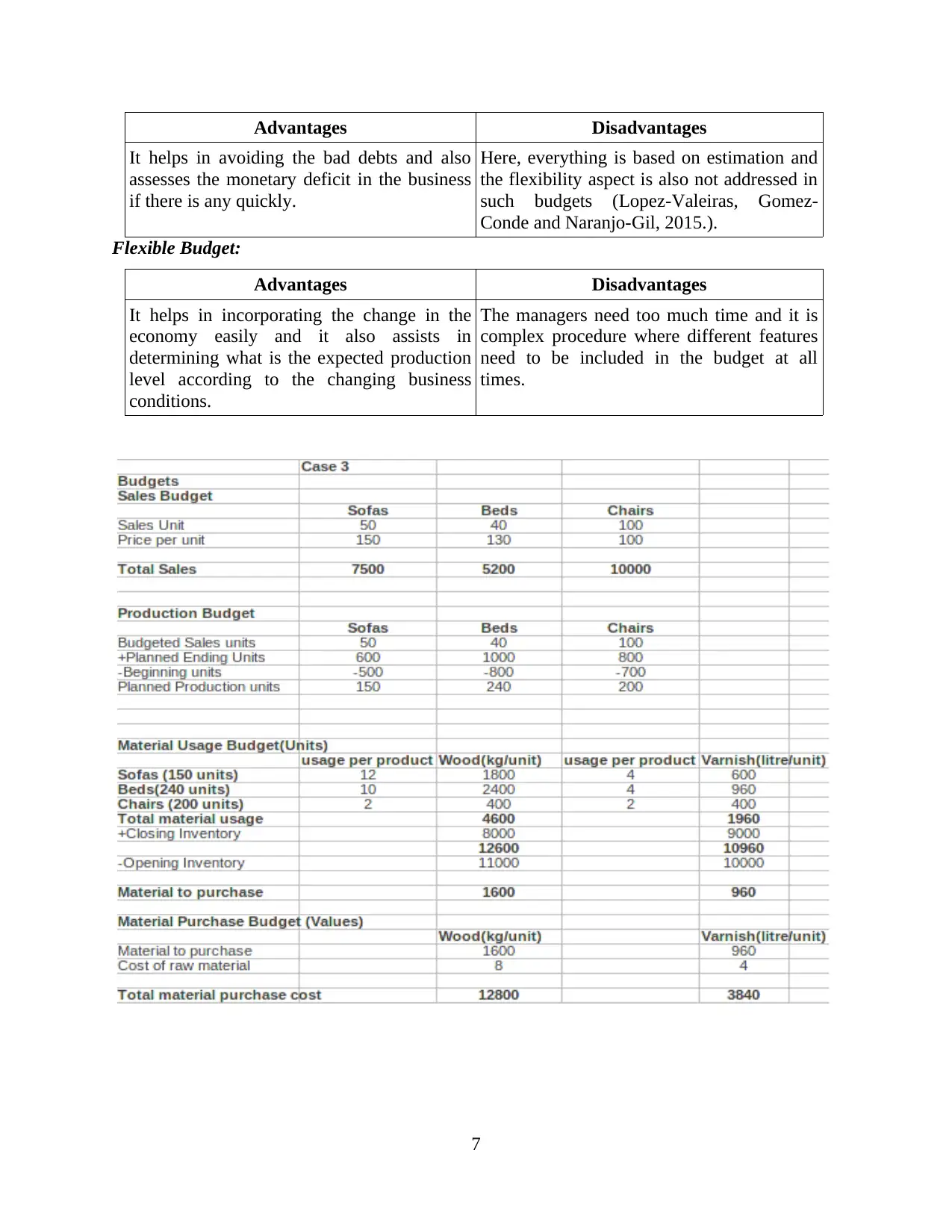
Advantages Disadvantages
It helps in avoiding the bad debts and also
assesses the monetary deficit in the business
if there is any quickly.
Here, everything is based on estimation and
the flexibility aspect is also not addressed in
such budgets (Lopez-Valeiras, Gomez-
Conde and Naranjo-Gil, 2015.).
Flexible Budget:
Advantages Disadvantages
It helps in incorporating the change in the
economy easily and it also assists in
determining what is the expected production
level according to the changing business
conditions.
The managers need too much time and it is
complex procedure where different features
need to be included in the budget at all
times.
7
It helps in avoiding the bad debts and also
assesses the monetary deficit in the business
if there is any quickly.
Here, everything is based on estimation and
the flexibility aspect is also not addressed in
such budgets (Lopez-Valeiras, Gomez-
Conde and Naranjo-Gil, 2015.).
Flexible Budget:
Advantages Disadvantages
It helps in incorporating the change in the
economy easily and it also assists in
determining what is the expected production
level according to the changing business
conditions.
The managers need too much time and it is
complex procedure where different features
need to be included in the budget at all
times.
7
⊘ This is a preview!⊘
Do you want full access?
Subscribe today to unlock all pages.

Trusted by 1+ million students worldwide
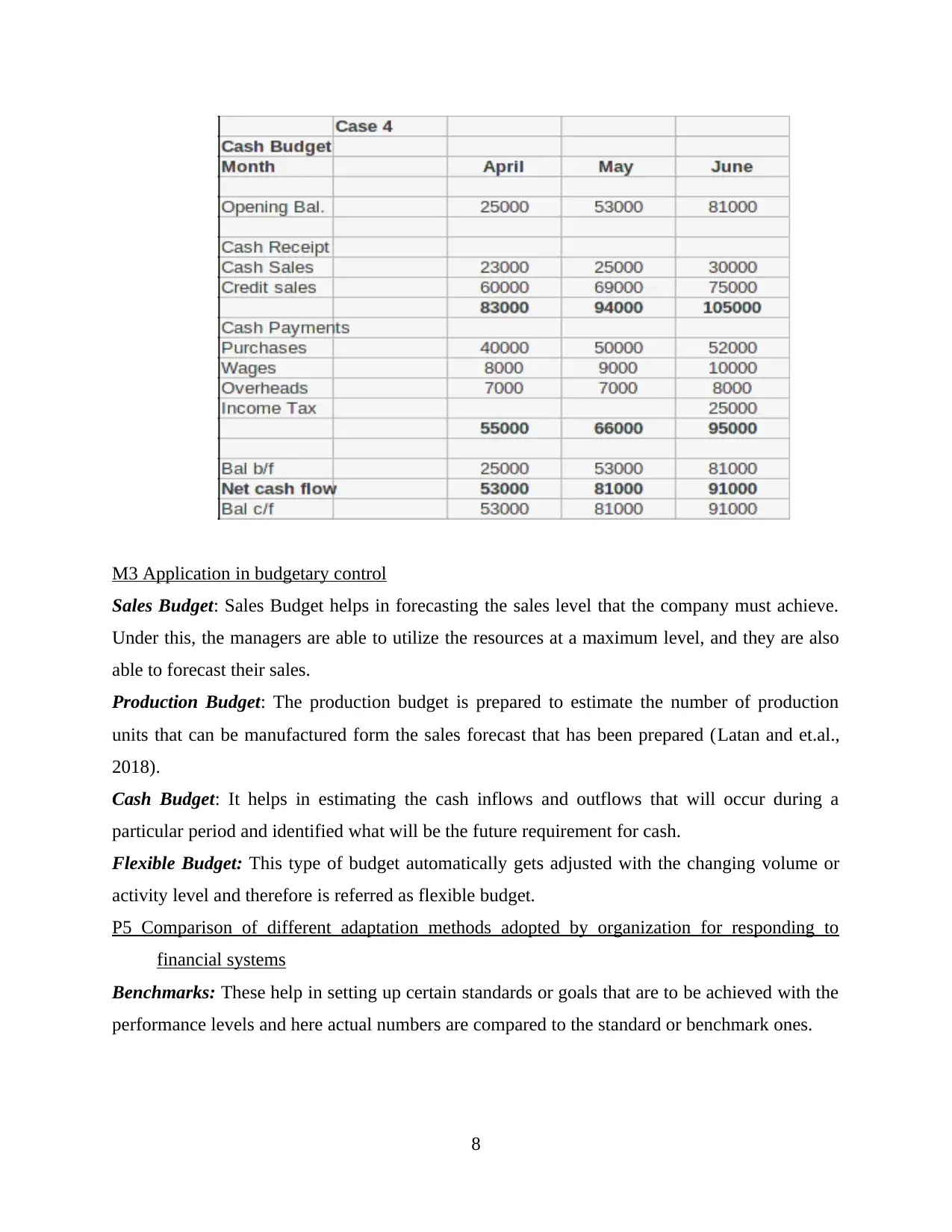
M3 Application in budgetary control
Sales Budget: Sales Budget helps in forecasting the sales level that the company must achieve.
Under this, the managers are able to utilize the resources at a maximum level, and they are also
able to forecast their sales.
Production Budget: The production budget is prepared to estimate the number of production
units that can be manufactured form the sales forecast that has been prepared (Latan and et.al.,
2018).
Cash Budget: It helps in estimating the cash inflows and outflows that will occur during a
particular period and identified what will be the future requirement for cash.
Flexible Budget: This type of budget automatically gets adjusted with the changing volume or
activity level and therefore is referred as flexible budget.
P5 Comparison of different adaptation methods adopted by organization for responding to
financial systems
Benchmarks: These help in setting up certain standards or goals that are to be achieved with the
performance levels and here actual numbers are compared to the standard or benchmark ones.
8
Sales Budget: Sales Budget helps in forecasting the sales level that the company must achieve.
Under this, the managers are able to utilize the resources at a maximum level, and they are also
able to forecast their sales.
Production Budget: The production budget is prepared to estimate the number of production
units that can be manufactured form the sales forecast that has been prepared (Latan and et.al.,
2018).
Cash Budget: It helps in estimating the cash inflows and outflows that will occur during a
particular period and identified what will be the future requirement for cash.
Flexible Budget: This type of budget automatically gets adjusted with the changing volume or
activity level and therefore is referred as flexible budget.
P5 Comparison of different adaptation methods adopted by organization for responding to
financial systems
Benchmarks: These help in setting up certain standards or goals that are to be achieved with the
performance levels and here actual numbers are compared to the standard or benchmark ones.
8
Paraphrase This Document
Need a fresh take? Get an instant paraphrase of this document with our AI Paraphraser
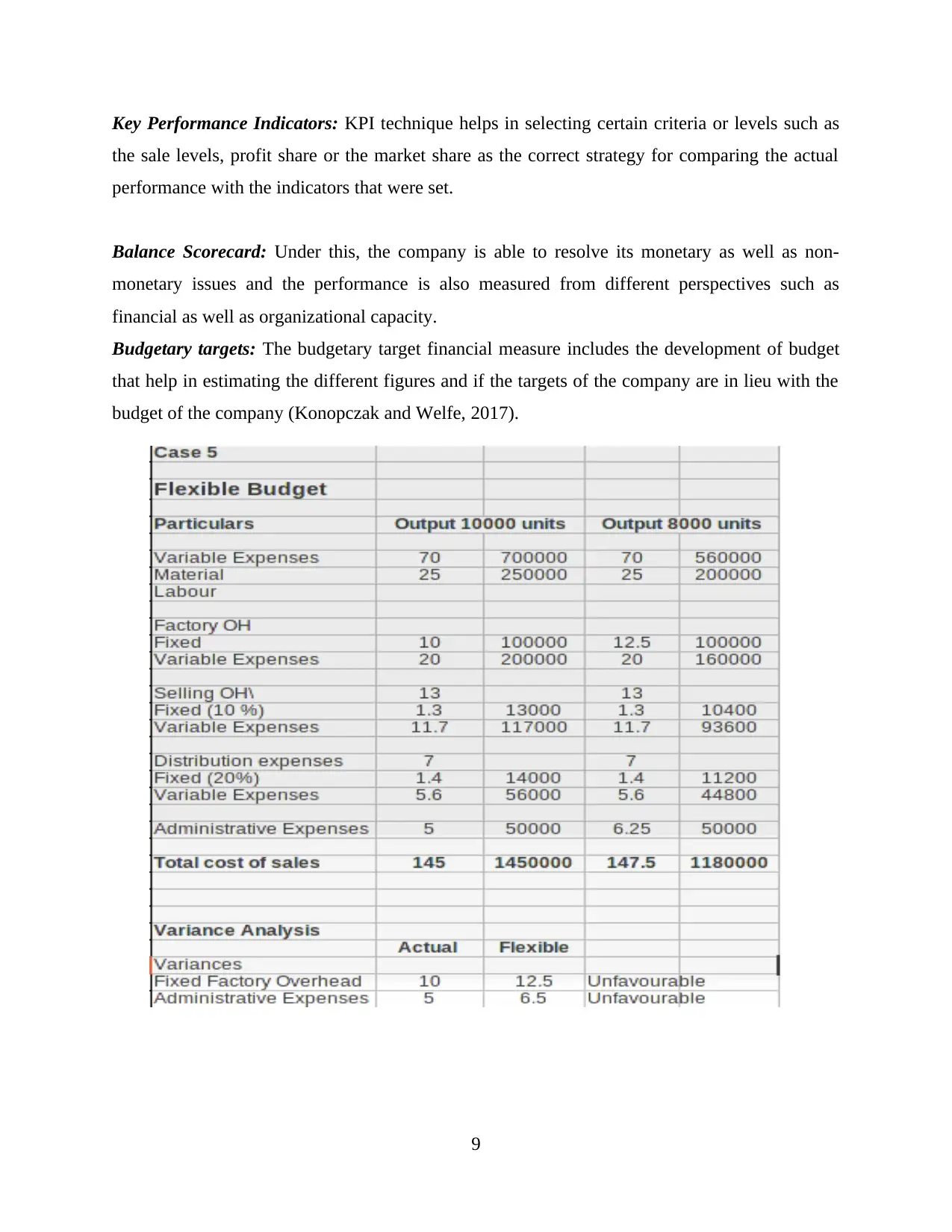
Key Performance Indicators: KPI technique helps in selecting certain criteria or levels such as
the sale levels, profit share or the market share as the correct strategy for comparing the actual
performance with the indicators that were set.
Balance Scorecard: Under this, the company is able to resolve its monetary as well as non-
monetary issues and the performance is also measured from different perspectives such as
financial as well as organizational capacity.
Budgetary targets: The budgetary target financial measure includes the development of budget
that help in estimating the different figures and if the targets of the company are in lieu with the
budget of the company (Konopczak and Welfe, 2017).
9
the sale levels, profit share or the market share as the correct strategy for comparing the actual
performance with the indicators that were set.
Balance Scorecard: Under this, the company is able to resolve its monetary as well as non-
monetary issues and the performance is also measured from different perspectives such as
financial as well as organizational capacity.
Budgetary targets: The budgetary target financial measure includes the development of budget
that help in estimating the different figures and if the targets of the company are in lieu with the
budget of the company (Konopczak and Welfe, 2017).
9
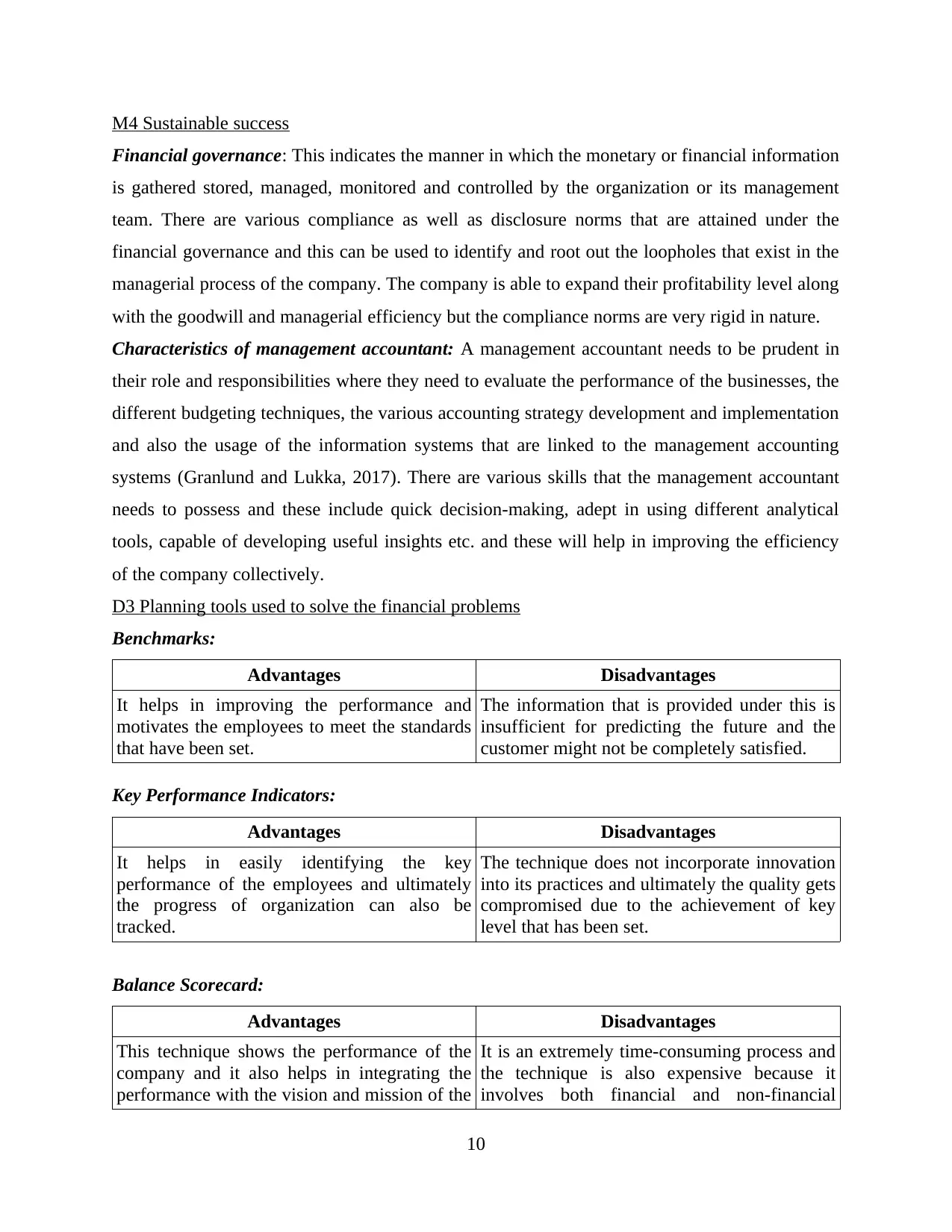
M4 Sustainable success
Financial governance: This indicates the manner in which the monetary or financial information
is gathered stored, managed, monitored and controlled by the organization or its management
team. There are various compliance as well as disclosure norms that are attained under the
financial governance and this can be used to identify and root out the loopholes that exist in the
managerial process of the company. The company is able to expand their profitability level along
with the goodwill and managerial efficiency but the compliance norms are very rigid in nature.
Characteristics of management accountant: A management accountant needs to be prudent in
their role and responsibilities where they need to evaluate the performance of the businesses, the
different budgeting techniques, the various accounting strategy development and implementation
and also the usage of the information systems that are linked to the management accounting
systems (Granlund and Lukka, 2017). There are various skills that the management accountant
needs to possess and these include quick decision-making, adept in using different analytical
tools, capable of developing useful insights etc. and these will help in improving the efficiency
of the company collectively.
D3 Planning tools used to solve the financial problems
Benchmarks:
Advantages Disadvantages
It helps in improving the performance and
motivates the employees to meet the standards
that have been set.
The information that is provided under this is
insufficient for predicting the future and the
customer might not be completely satisfied.
Key Performance Indicators:
Advantages Disadvantages
It helps in easily identifying the key
performance of the employees and ultimately
the progress of organization can also be
tracked.
The technique does not incorporate innovation
into its practices and ultimately the quality gets
compromised due to the achievement of key
level that has been set.
Balance Scorecard:
Advantages Disadvantages
This technique shows the performance of the
company and it also helps in integrating the
performance with the vision and mission of the
It is an extremely time-consuming process and
the technique is also expensive because it
involves both financial and non-financial
10
Financial governance: This indicates the manner in which the monetary or financial information
is gathered stored, managed, monitored and controlled by the organization or its management
team. There are various compliance as well as disclosure norms that are attained under the
financial governance and this can be used to identify and root out the loopholes that exist in the
managerial process of the company. The company is able to expand their profitability level along
with the goodwill and managerial efficiency but the compliance norms are very rigid in nature.
Characteristics of management accountant: A management accountant needs to be prudent in
their role and responsibilities where they need to evaluate the performance of the businesses, the
different budgeting techniques, the various accounting strategy development and implementation
and also the usage of the information systems that are linked to the management accounting
systems (Granlund and Lukka, 2017). There are various skills that the management accountant
needs to possess and these include quick decision-making, adept in using different analytical
tools, capable of developing useful insights etc. and these will help in improving the efficiency
of the company collectively.
D3 Planning tools used to solve the financial problems
Benchmarks:
Advantages Disadvantages
It helps in improving the performance and
motivates the employees to meet the standards
that have been set.
The information that is provided under this is
insufficient for predicting the future and the
customer might not be completely satisfied.
Key Performance Indicators:
Advantages Disadvantages
It helps in easily identifying the key
performance of the employees and ultimately
the progress of organization can also be
tracked.
The technique does not incorporate innovation
into its practices and ultimately the quality gets
compromised due to the achievement of key
level that has been set.
Balance Scorecard:
Advantages Disadvantages
This technique shows the performance of the
company and it also helps in integrating the
performance with the vision and mission of the
It is an extremely time-consuming process and
the technique is also expensive because it
involves both financial and non-financial
10
⊘ This is a preview!⊘
Do you want full access?
Subscribe today to unlock all pages.

Trusted by 1+ million students worldwide
1 out of 15
Related Documents
Your All-in-One AI-Powered Toolkit for Academic Success.
+13062052269
info@desklib.com
Available 24*7 on WhatsApp / Email
![[object Object]](/_next/static/media/star-bottom.7253800d.svg)
Unlock your academic potential
Copyright © 2020–2025 A2Z Services. All Rights Reserved. Developed and managed by ZUCOL.





